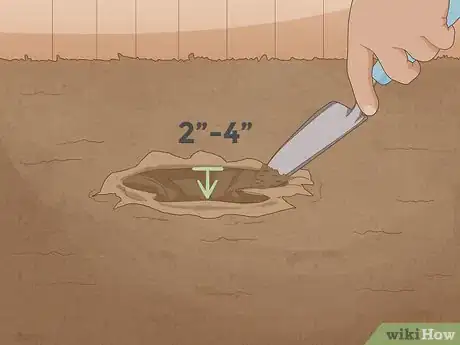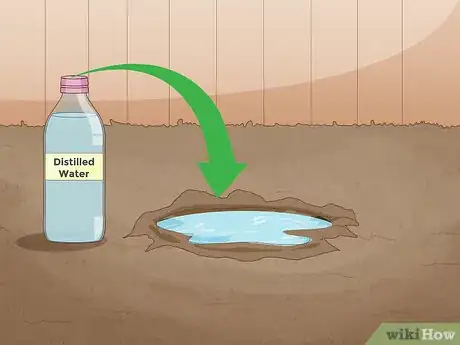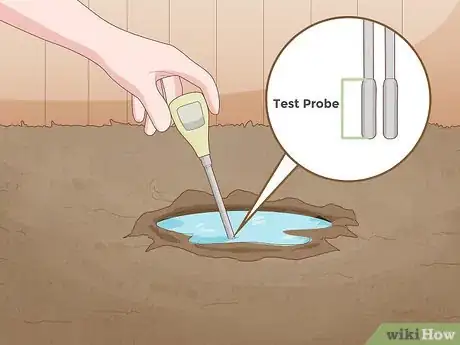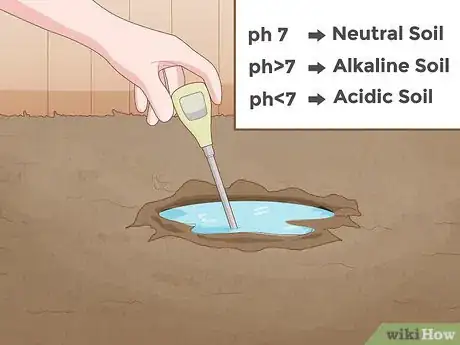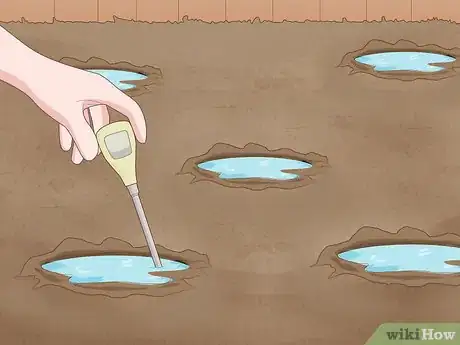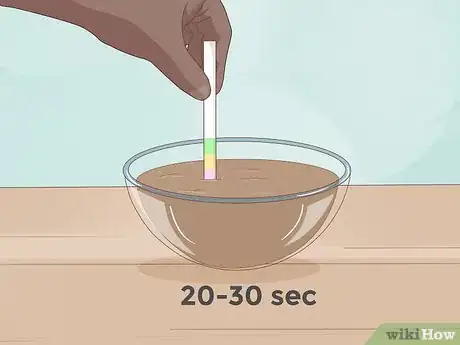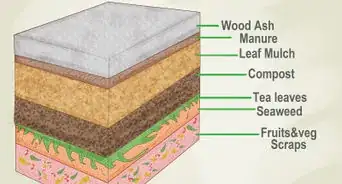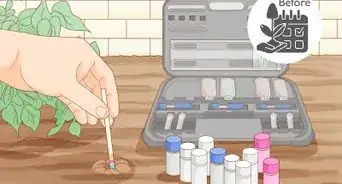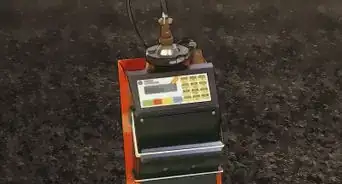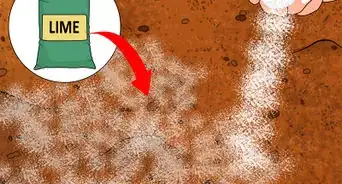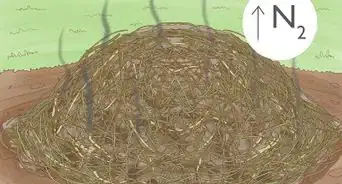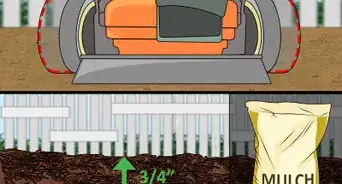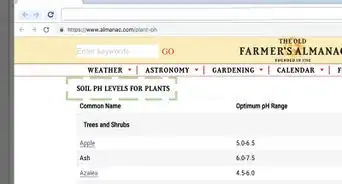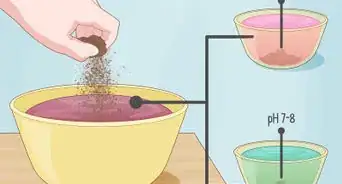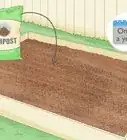This article was co-authored by Andrew Carberry, MPH. Andrew Carberry is a Food Systems Expert and the Senior Program Associate at the Wallace Centere at Winrock International in Little Rock, Arkansas. He has worked in food systems since 2008 and has experience working on farm-to-school projects, food safety programs, and working with local and state coalitions in Arkansas. He is a graduate of the College of William and Mary and holds a Masters degree in public health and nutrition from the University of Tennessee.
wikiHow marks an article as reader-approved once it receives enough positive feedback. This article received 18 testimonials and 91% of readers who voted found it helpful, earning it our reader-approved status.
This article has been viewed 1,150,960 times.
Do you want to plant a garden? Then it is important to know about the pH of your soil. The pH is a measure of the soil's acidity or alkalinity. Different plants require different pH levels to thrive. Once you know your soil's pH, you can adjust your garden accordingly to help your plants grow. Getting a measurement is easy, and there are a number of different ways to do it.
Steps
Testing Soil pH with a Commercial Test Probe
-
1Dig a small hole in the soil. Use a trowel or spade to dig a hole 2–4 inches (5.1–10.2 cm) deep. Break up the soil within the hole and remove any twigs or foreign debris.
-
2Fill the hole with water. Use distilled (not spring) water. You can find this in your local pharmacy. Rainwater is slightly acidic, and bottled or tap water tends to be slightly alkaline. Fill the hole until you have a muddy pool at the bottom.Advertisement
-
3Insert the test probe into the mud. Make sure your tester is clean and calibrated (for a more exact measurement). Wipe the probe with a tissue or clean cloth, and insert it into the mud.
-
4Hold it there for 60 seconds and take a reading. pH is usually measured on a scale of 1-14, though the tester may not include this entire range.
- A pH of 7 indicates neutral soil.
- A pH above 7 indicates alkaline soil.
- A pH below 7 indicates acidic soil.
-
5Take several measurements in different spots in the garden. A single reading may be an anomaly, so it's good to get an idea of the average pH in a plot. If they're all around the same, take the average and amend the soil accordingly. If one spot is very different than the rest, however, you may need to "spot treat" it.
Using Paper Test Strips
-
1Purchase pH test strips. Test strips, also known as litmus paper, are a quick and easy way to measure the pH of your soil. You can purchase them online or at your local garden store.[1]
-
2Mix a handful of soil with room-temperature distilled water. Take a handful of the soil you'd like to test and put it in a bowl. Then, pour some distilled water into the bowl until the dirt is the consistency of a milkshake. You can give the mixture a stir to ensure the water is fully incorporated.[2]
-
3Dip a pH test strip in the mixture for 20-30 seconds. Holding your pH test strip at the non-reading end, dip the strip into the dirt mixture for 20-30 seconds. This test time can vary, so consult the directions on your specific test strips to determine the proper dipping time. When the test time is up, lift the pH strip from the water, and dip it briefly in distilled water to clean off the dirt.
-
4Compare your pH strip to the test kit's key. Use the key included in your pH test kit to read the pH of your soil. Normally this key is color-coded. Compare your strip to the colors available, and select the one that most resembles your result. The key will equate this color with the pH number of your soil.[3]
Changing Your Soil pH
-
1Make your soil less acidic. If your soil pH tested below 7, add a cup of dolomite or quick lime to the soil. Mix well, then retest with your probe. Use this method to slowly change the pH of your soil. Wood ash in moderation helps as well. Both are available at local gardening centers.
- Follow the advice in your commercial test probe kit to determine how much of these substances you will need to add to achieve the desired pH. If you need to change your soil pH level more than one full point, contact a local gardening professional. They can help you calibrate your soil so it can be amended most successfully.[4]
-
2Make your soil less alkaline. If your soil pH tested above 7, add a cup of organic matter, such as pine needles, peat moss, or decomposed tree leaves. Then, retest the soil to gauge the new pH. Add additional cups, testing as necessary, until you reach the desired level. Sulfur is very effective as well.
- Use the instructions in your commercial test probe kit to determine how much of these additives you will need to add to achieve your desired pH. If your soil needs to be adjusted more than a full pH point, contact a local gardening or landscaping professional. They can help you calibrate your soil to the right level through an on-site evaluation.[5]
-
3Change your soil pH to suit specific plants. For example, add sulfur to a certain area of your garden to encourage beautiful blue blooms on your hydrangeas, which prefer more acidic soils. The pH of your soil does not need to be uniform your entire garden over; feel free to alter it to support different plants. You can consult the Old Farmer's Almanac to determine the best pH for your particular garden. Some plants prefer a pH of 7 while some fruits favor a lower pH.
Community Q&A
Did you know you can get answers researched by wikiHow Staff?
Unlock staff-researched answers by supporting wikiHow
-
QuestionCan you use pH strips to test soil?
 wikiHow Staff EditorThis answer was written by one of our trained team of researchers who validated it for accuracy and comprehensiveness.
wikiHow Staff EditorThis answer was written by one of our trained team of researchers who validated it for accuracy and comprehensiveness.
Staff Answer wikiHow Staff EditorStaff AnswerCertainly, you can use pH strips to test soil. The second method above explains the process for using them: How to Use Paper Test Strips.
wikiHow Staff EditorStaff AnswerCertainly, you can use pH strips to test soil. The second method above explains the process for using them: How to Use Paper Test Strips. -
QuestionHow is soil pH measured?
 wikiHow Staff EditorThis answer was written by one of our trained team of researchers who validated it for accuracy and comprehensiveness.
wikiHow Staff EditorThis answer was written by one of our trained team of researchers who validated it for accuracy and comprehensiveness.
Staff Answer wikiHow Staff EditorStaff AnswerThe pH of soil is worked out by measuring the hydrogen ion activity in a liquid solution. Soil pH can be measured in several ways, depending on what is available to you. Typical ways to measure soil pH are: Using a commercial test probe or glass electrode, or a colorimetric test kit, or by using test paper strips. The methodology for measuring is explained in the steps above.
wikiHow Staff EditorStaff AnswerThe pH of soil is worked out by measuring the hydrogen ion activity in a liquid solution. Soil pH can be measured in several ways, depending on what is available to you. Typical ways to measure soil pH are: Using a commercial test probe or glass electrode, or a colorimetric test kit, or by using test paper strips. The methodology for measuring is explained in the steps above. -
QuestionHow do you test pH paper in soil?
 wikiHow Staff EditorThis answer was written by one of our trained team of researchers who validated it for accuracy and comprehensiveness.
wikiHow Staff EditorThis answer was written by one of our trained team of researchers who validated it for accuracy and comprehensiveness.
Staff Answer wikiHow Staff EditorStaff AnswerTo use pH test strips for testing soil, see the full instructions in this wikiHow: How to Use Paper Test Strips.
wikiHow Staff EditorStaff AnswerTo use pH test strips for testing soil, see the full instructions in this wikiHow: How to Use Paper Test Strips.
Warnings
- As noted above, the water you pour into the hole can affect your reading if the pH of the water is not neutral. Use distilled water for all testing.⧼thumbs_response⧽
- Some testers will function differently than that described in this article. Always make sure to read the manufacturer's instructions carefully to ensure accurate readings.⧼thumbs_response⧽
Things You'll Need
- pH tester
- pH test strips
- Small garden shovel (often called a "spade" or "trowel")
- Water with pH of 7 or distilled water
- Multiple cups
References
- ↑ http://mikesbackyardnursery.com/2015/02/complete-guide-to-soil-ph-testing/
- ↑ http://mikesbackyardnursery.com/2015/02/complete-guide-to-soil-ph-testing/
- ↑ http://mikesbackyardnursery.com/2015/02/complete-guide-to-soil-ph-testing/
- ↑ http://www.sunset.com/garden/garden-basics/acid-alkaline-soil-modifying-ph
- ↑ http://www.sunset.com/garden/garden-basics/acid-alkaline-soil-modifying-ph
About This Article
To test your soil’s pH, first, go online or to your local garden center and buy pH test strips, which are also called litmus paper. Then, take a handful of the soil you want to test and mix it with just enough distilled water to give it the consistency of a milkshake. Next, put the test strip into the dirt mixture and hold it there for 20-30 seconds. Remove it from the dirt and dip it quickly into distilled water to clean it off. Finally, you can determine your soil’s pH by comparing the strip's coloration to the color-coded key that came with the test strips. For information from our reviewer on testing soil pH by using a commercial test probe, read on!
